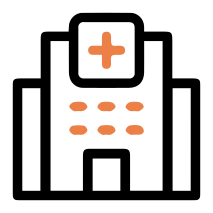Abdominal Pain: Causes, Symptoms & Treatment
Abdominal pain is a common and often distressing symptom that can result from a variety of conditions, ranging from benign to serious. It can affect any part of the abdomen and vary in intensity from mild discomfort to severe pain. Understanding the causes, symptoms, and treatment options for abdominal pain is essential for effective management and seeking appropriate medical care.
Causes of Abdominal Pain
Abdominal pain can arise from many different causes, each affecting different areas and organs within the abdomen. Identifying the root cause is crucial for appropriate treatment and relief.
1. Gastrointestinal Disorders:
- Gastritis: Inflammation of the stomach lining caused by factors such as infection, excessive alcohol use, or chronic use of certain medications (e.g., NSAIDs). Symptoms include upper abdominal pain, nausea, and vomiting.
- Peptic Ulcers: Sores that develop on the lining of the stomach, small intestine, or esophagus, often due to Helicobacter pylori infection or excessive use of nonsteroidal anti-inflammatory drugs (NSAIDs). Symptoms include burning pain, bloating, and nausea.
- Irritable Bowel Syndrome (IBS): A functional gastrointestinal disorder characterized by abdominal pain, bloating, and changes in bowel habits, such as diarrhea, constipation, or both. The exact cause is unclear, but it is often related to stress or dietary triggers.
- Inflammatory Bowel Disease (IBD): Includes Crohn’s disease and ulcerative colitis, conditions characterized by chronic inflammation of the gastrointestinal tract. Symptoms include persistent abdominal pain, diarrhea, weight loss, and fatigue.
- Appendicitis: Inflammation of the appendix, typically presenting with sudden onset pain in the lower right abdomen, often accompanied by nausea, vomiting, and fever. Appendicitis is a medical emergency requiring surgical intervention.
- Diverticulitis: Inflammation or infection of small pouches (diverticula) that can form in the walls of the colon, leading to symptoms such as lower abdominal pain, fever, and changes in bowel habits.
2. Genitourinary Disorders:
- Urinary Tract Infection (UTI): Infection in the urinary system, including the bladder or kidneys. Symptoms include lower abdominal pain, frequent urination, burning sensation during urination, and cloudy or bloody urine.
- Kidney Stones: Hard deposits of minerals and salts that form in the kidneys and can cause severe pain when they move through the urinary tract. Symptoms include intense pain in the lower abdomen and back, blood in urine, and frequent urination.
- Ovarian Cysts: Fluid-filled sacs that develop on the ovaries, often causing lower abdominal pain, bloating, and irregular menstrual cycles. Larger cysts may cause more significant discomfort or complications.
3. Reproductive Health Issues:
- Endometriosis: A condition where tissue similar to the lining of the uterus grows outside the uterus, causing pelvic pain, painful periods, and pain during intercourse.
- Pelvic Inflammatory Disease (PID): An infection of the female reproductive organs, often resulting from sexually transmitted infections. Symptoms include lower abdominal pain, fever, and abnormal vaginal discharge.
4. Hernias:
- Inguinal Hernia: Occurs when part of the intestine protrudes through a weak spot in the abdominal wall or inguinal canal. Symptoms include a bulge in the groin area, pain, and discomfort, especially when lifting or straining.
- Hiatal Hernia: Occurs when part of the stomach pushes through the diaphragm into the chest cavity. Symptoms include heartburn, chest pain, and difficulty swallowing.
5. Other Conditions:
- Abdominal Aortic Aneurysm: A bulging or dilation in the wall of the abdominal aorta, which can be life-threatening if it ruptures. Symptoms include severe, sudden abdominal or back pain and may be accompanied by a pulsating feeling in the abdomen.
- Gastroenteritis: Inflammation of the stomach and intestines often caused by viral or bacterial infections. Symptoms include abdominal cramping, diarrhea, nausea, and vomiting.
- Constipation: Difficulty in passing stools or infrequent bowel movements can lead to abdominal pain and discomfort. It may be caused by dietary factors, dehydration, or underlying medical conditions.
Symptoms of Abdominal Pain
The nature of abdominal pain can provide important clues about its cause. Symptoms may vary depending on the underlying condition and may include:
- Localized Pain: Pain that is confined to a specific area of the abdomen, such as the lower right quadrant in appendicitis or the upper right quadrant in gallbladder issues.
- Generalized Pain: Pain that is spread throughout the abdomen, which can be indicative of conditions like gastritis, gastrointestinal infections, or IBD.
- Crampy Pain: Intermittent, cramp-like pain often associated with conditions like IBS or menstruation.
- Sharp Pain: Sudden and intense pain, which may suggest acute conditions such as appendicitis or kidney stones.
- Dull or Aching Pain: Persistent, dull pain that may be less intense but still bothersome, often seen in chronic conditions like IBD or hernias.
- Radiating Pain: Pain that spreads to other areas, such as back pain associated with kidney stones or pain that radiates to the groin with hernias.
- Accompanying Symptoms: Nausea, vomiting, fever, diarrhea, constipation, or changes in bowel habits can help identify the underlying cause of abdominal pain.
Diagnosis of Abdominal Pain
Diagnosing the cause of abdominal pain involves a thorough evaluation by a healthcare provider. The diagnostic process typically includes:
- Medical History: Detailed information about the onset, duration, and nature of the pain, as well as associated symptoms and any relevant medical history.
- Physical Examination: Assessment of the abdomen through palpation, auscultation, and inspection to identify areas of tenderness, swelling, or abnormal masses.
- Laboratory Tests: Blood tests, urinalysis, and stool tests to identify signs of infection, inflammation, or other abnormalities.
- Imaging Studies: Techniques such as ultrasound, computed tomography (CT) scans, or magnetic resonance imaging (MRI) to visualize internal structures and identify potential causes of pain.
- Endoscopy: Procedures like gastroscopy or colonoscopy may be used to directly examine the gastrointestinal tract and obtain tissue samples for further analysis.
Treatment Options for Abdominal Pain
Treatment for abdominal pain depends on the underlying cause and severity of the symptoms. Options may include:
1. Medications:
- Pain Relievers: Over-the-counter medications like acetaminophen or ibuprofen can help manage mild to moderate pain. Stronger pain medications may be prescribed for more severe pain.
- Antacids and Acid Reducers: Medications such as antacids, proton pump inhibitors (PPIs), or H2-receptor antagonists can treat conditions like gastritis or peptic ulcers by reducing stomach acid.
- Antibiotics: If the abdominal pain is due to bacterial infections, such as a UTI or diverticulitis, antibiotics may be prescribed to treat the infection.
- Anti-inflammatory Drugs: Nonsteroidal anti-inflammatory drugs (NSAIDs) can reduce inflammation and pain associated with conditions like IBD or ovarian cysts.
- Laxatives: For constipation-related pain, laxatives or stool softeners can help relieve symptoms and improve bowel movements.
2. Dietary and Lifestyle Changes:
- Dietary Adjustments: Modifying the diet to avoid trigger foods, eat smaller meals, or follow a specific diet plan can help manage symptoms of conditions like IBS or gastritis.
- Hydration: Drinking plenty of fluids can help prevent dehydration and alleviate symptoms of gastrointestinal disorders and kidney stones.
- Stress Management: Reducing stress through relaxation techniques, exercise, and therapy can help manage symptoms of functional gastrointestinal disorders.
3. Surgical Interventions:
- Appendectomy: Surgical removal of the appendix for appendicitis, often performed as an emergency procedure.
- Hernia Repair: Surgical correction of hernias to relieve pain and prevent complications.
- Cholecystectomy: Removal of the gallbladder in cases of gallstones causing significant pain or complications.
- Bowel Resection: Surgical removal of affected segments of the intestine for conditions like Crohn’s disease or diverticulitis.
4. Other Treatments:
- Physical Therapy: For conditions like pelvic floor dysfunction, physical therapy can help improve symptoms and function.
- Bladder Instillations: In cases of interstitial cystitis or chronic bladder pain, bladder instillations may be used to deliver medication directly to the bladder.
- Behavioral Therapies: Cognitive behavioral therapy (CBT) or biofeedback may be used to manage chronic pain and associated symptoms.
Management and Follow-Up
Managing abdominal pain involves ongoing care and follow-up to address the underlying condition and prevent recurrence. Key components include:
- Regular Monitoring: Continued assessment and monitoring by healthcare providers to track progress and make necessary adjustments to the treatment plan.
- Patient Education: Providing information about the condition, treatment options, and self-care strategies to help individuals manage their symptoms effectively.
- Lifestyle Adjustments: Encouraging healthy lifestyle changes, including a balanced diet, regular exercise, and stress management techniques.
- Coordination of Care: Collaboration among specialists, such as gastroenterologists, urologists, and surgeons, to ensure comprehensive care and address all aspects of abdominal pain.
Frequently Asked Questions
- What causes abdominal pain?
Abdominal pain can result from various causes, including gastrointestinal disorders (e.g., gastritis, IBS
), genitourinary issues (e.g., kidney stones, UTIs), reproductive health problems (e.g., endometriosis), and other conditions (e.g., hernias, infections).
- How is abdominal pain diagnosed?
Diagnosis involves a detailed medical history, physical examination, laboratory tests, imaging studies (e.g., ultrasound, CT scan), and sometimes endoscopic procedures to identify the underlying cause. - What are the common symptoms associated with abdominal pain?
Symptoms may include localized or generalized pain, cramping, sharp or dull pain, bloating, nausea, vomiting, changes in bowel habits, and associated symptoms like fever or urinary issues. - When should I seek medical attention for abdominal pain?
Seek medical attention if you experience severe, persistent, or worsening abdominal pain, especially if accompanied by symptoms such as fever, vomiting, difficulty breathing, or significant changes in bowel or urinary habits. - What treatments are available for abdominal pain?
Treatments depend on the underlying cause and may include medications (e.g., pain relievers, antibiotics), dietary and lifestyle changes, surgical interventions, and other therapies such as physical therapy or behavioral treatments. - Can dietary changes help with abdominal pain?
Yes, dietary adjustments can help manage symptoms related to conditions like IBS or gastritis. Avoiding trigger foods, staying hydrated, and eating a balanced diet may provide relief. - How is abdominal pain related to gastrointestinal disorders treated?
Treatment for gastrointestinal disorders may include medications to reduce inflammation or acid, dietary changes, and sometimes surgical interventions for severe cases. - What are the signs of a serious abdominal condition?
Serious signs include sudden, severe pain, persistent or worsening symptoms, symptoms accompanied by fever, vomiting, or blood in stool or urine, and signs of shock or dehydration. - Are there any home remedies for managing abdominal pain?
Home remedies may include applying heat to the abdomen, drinking herbal teas (e.g., peppermint, ginger), staying hydrated, and using over-the-counter pain relievers as directed. However, consult a healthcare provider for persistent or severe pain. - How can I prevent abdominal pain?
Preventive measures include maintaining a healthy diet, staying hydrated, managing stress, avoiding known triggers, and seeking regular medical care for chronic conditions to manage symptoms and prevent complications.











 and then
and then